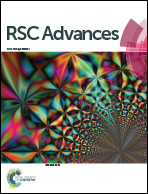Controlled synthesis of pure Au25(2-Nap)18 and Au36(2-Nap)24 nanoclusters from 2-(diphenylphosphino)pyridine protected Au nanoclusters†
Abstract
The controlled synthesis of pure Au25(2-Nap)18 and Au36(2-Nap)24 nanoclusters were achieved via etching 2-(diphenylphosphino)-pyridine protected polydispersed Au nanoclusters with a mass of 1 to 3 kDa. Au25(2-Nap)18 was obtained at the etching temperature of 80 °C, while Au36(2-Nap)24 was synthesized at the etching temperature of 50 °C. This demonstrates that the simple adjustment of the etching temperatures can realize the controlled synthesis of different atomically precise Au nanoclusters.


 Please wait while we load your content...
Please wait while we load your content...